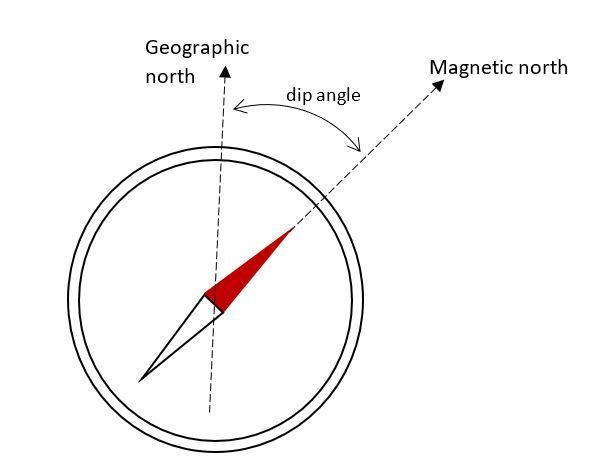
Why is the angle of dip $90^{\circ}$ at the magnetic pole?
Answer
429.3k+ views
Hint: The Earth behaves like a big bar magnet in which the magnetic lines emerge from the north pole and go to the south pole to form closed lines. The magnetic declination is the angle made between the geographical north and the magnetic north.
Complete step-by-step answer:
When a magnet is suspended freely in presence of an external magnetic field, it aligns itself with the field lines. And we know that the magnetic field lines of the Earth are not parallel to its surface, when a compass needle is suspended freely, it will make a certain angle with the horizontal component of the Earth’s magnetic field, which is called the magnetic dip or the angle of dip or magnetic declination. From the magnetic north pole to the magnetic south pole, it varies from $-90^{\circ}$ to $+90^{\circ}$.

The magnetic dip at the equator is zero degrees as the magnetic lines are parallel to the surface there and are perpendicular to the surface at the poles. So the angle of dip becomes 90 degree at the magnetic pole
Additional Information
Contour lines which connect the point of equal declination are known as the isogonic lines and the lines which connect the locations having zero declination are called the agonic lines.
Magnetic declination varies from place to place and also with the passage of time. The dip angle is also affected by the presence of eternal magnetic fields at a location, like in forests and due to the mineral beds below ground.
With time, the magnetic declination at a given location also changes and the change is very slow, almost 2 – 2.5 degrees in a hundred years. This change also depends on the location, for some point near poles, the change is around one degree every three years.
Note: The dip angle is also called the magnetic dip, magnetic declination. The magnetic north may also be confused with the geographic north, but it's partially true. As at many locations, both may be the same based on the dip angle.
Complete step-by-step answer:
When a magnet is suspended freely in presence of an external magnetic field, it aligns itself with the field lines. And we know that the magnetic field lines of the Earth are not parallel to its surface, when a compass needle is suspended freely, it will make a certain angle with the horizontal component of the Earth’s magnetic field, which is called the magnetic dip or the angle of dip or magnetic declination. From the magnetic north pole to the magnetic south pole, it varies from $-90^{\circ}$ to $+90^{\circ}$.

The magnetic dip at the equator is zero degrees as the magnetic lines are parallel to the surface there and are perpendicular to the surface at the poles. So the angle of dip becomes 90 degree at the magnetic pole
Additional Information
Contour lines which connect the point of equal declination are known as the isogonic lines and the lines which connect the locations having zero declination are called the agonic lines.
Magnetic declination varies from place to place and also with the passage of time. The dip angle is also affected by the presence of eternal magnetic fields at a location, like in forests and due to the mineral beds below ground.
With time, the magnetic declination at a given location also changes and the change is very slow, almost 2 – 2.5 degrees in a hundred years. This change also depends on the location, for some point near poles, the change is around one degree every three years.
Note: The dip angle is also called the magnetic dip, magnetic declination. The magnetic north may also be confused with the geographic north, but it's partially true. As at many locations, both may be the same based on the dip angle.
Recently Updated Pages
Master Class 12 Biology: Engaging Questions & Answers for Success

Master Class 12 Physics: Engaging Questions & Answers for Success

Master Class 12 Economics: Engaging Questions & Answers for Success

Master Class 12 Maths: Engaging Questions & Answers for Success

Master Class 10 English: Engaging Questions & Answers for Success

Master Class 10 Social Science: Engaging Questions & Answers for Success

Trending doubts
Differentiate between homogeneous and heterogeneous class 12 chemistry CBSE

Which are the Top 10 Largest Countries of the World?

Why is the cell called the structural and functional class 12 biology CBSE

a Tabulate the differences in the characteristics of class 12 chemistry CBSE

Pomato is a Somatic hybrid b Allopolyploid c Natural class 12 biology CBSE

Who discovered the cell and how class 12 biology CBSE




